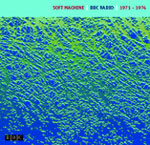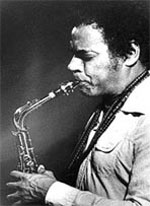Is It Jazz?
| |

| Fans of Soft Machine are frequently divided about which phase of their continual evolution showcased the band at its best. Given that they metamorphosed from would-be pop band through innovative jazz-rockers to out and out free players then back to an inauspicious demise involving a more anaemic hybrid of jazz rock, that's understandable. This latest release from the BBC archive will please many but probably not all.
The double cd takes up the story around those turbulent times which produced their fifth studio album. Robert Wyatt had left to be replaced by Phil Howard, a drummer for whom playing was nothing less than a total body workout. He was the ideal partner for Elton Dean's incandescent alto explorations, pushing him to extremes which, at the time, may have repelled some rock fans who witnessed the dizzying interplay demonstrated by the duo, along with keyboard man Mike Ratledge and bassist, Hugh Hopper. Tracks like ´As If', ´Drop' and Welcome To Frillsville' are examples of this most ´free' incarnation of the band. The first two are far superior to the studio versions and the last one has not been available before. It may have been difficult for the personnel involved but it makes for riveting listening. All three are full of tension and inevitably catch a band in the throes of change. This flux manifested itself in the departure of Dean and Howard and the entrance of multi-instrumentalist Karl Jenkins with drummer, John Marshall. The heady days of pushing the genre to some kind of extreme ended here. Things began to settle into a routine seemingly dictated by Jenkins' compositions as opposed to the free improvisation favoured by Dean. But there are still inclinations towards fire on the suite, ´Fanfare/All White/MC/Drop'. Ratledge employs that trademark spiky fuzz organ to spine-tingling effect and collectively they spark each other off in a way that, again, the studio recordings of this line-up somehow never managed to do. Their take on Ratledge's ´Stanley Stamp's Gibbon Album' also bears this out. With the departure of Hugh Hopper the band's sound inevitably altered. His replacement, Roy Babbington, plays fuzz bass, briefly on ´Sinepost' and while he may have been, and still is, well respected in the jazz community he can't match Hopper's inventive fretwork within the ambit of this band. Though, of course, Soft Machine had now become another band , anyway, a mini-Nucleus in fact. Coming after the truly exciting free playing this was not my favourite manifestation. However, on this outing they are more interesting, breathing new life into tracks from their ´Bundles' album, including Ratledge's ´The Man Who Waved At Trains'. Their version of Jenkins' ´Hazard Profile' is sharper too with Allan Holdsworth tearing off some energetic guitar strokes while Ratledge takes a similar approach to the synthesiser. Maybe the studio sound dulled some of this work because it does appear fresher here. So a mixed album to some extent but still a very important document showing the Softs ´live' and mutating. |

| I will always associate
Jimmy Lyons with the work of Cecil Taylor, demanding and uncompromising as
that can often be pushing at the forefront of jazz improvisation and exploration.
But it is his role as leader, composer and soloist with his own trios and
quartet that is showcased here. On 5 cds stretching from 1972 to 1985 Lyons
and a variety of equally passionate musicians are caught ´live' and exploring
freedom within written structures. The sound quality may be a little uneven
in places but not enough to detract from the actual playing. 1972 finds the quartet in Sam Rivers' studio giving ´Jump Up' a thorough workout. This cut features the altoist locking horns with another of Taylor's associates, trumpeter, Raphe Malik. These two are ably supported by Hayes Burnett, bass, and Sydney Smart on drums delivering music that has an urgency and drive which the years between have done nothing to lessen. A potent reminder that great music is often timeless. Back at Rivbea Studio in 1975, ´Heritage II' features an abundance of wiry alto playing, again delivered in an urgent, direct manner. Short, punchy phrases and longer shapely constructions tumble from the horn while bass and drums provide exactly what's needed, confirming my frequently stated belief that this type of trio is one of the peaks of perfection in jazz. But to hear Lyons solo, as on ´Mary Mary Intro' from 1981, is another source of joy. The sound is fuller somehow on this recording and feels as though he's playing right there at your shoulder. Notes rush by in flurries, taut and elliptical, or come in staccato bursts, ceaselessly inventive. His tone is assertive, keening and slightly querulous, somehow both fierce and fragile. Things just keep getting better. Another trio recording, ´We Sneezawee', from 1984, pitches his relentless energies with Karen Borca's bassoon. I know, it's not the first instrument to come to mind in a jazz context but its often lugubrious voice is transformed here into a grittier, grainy counterpart to the alto. The two constantly duel, occasionally taking some solo space, and it is an unalloyed pleasure to hear bassoon pitched against Paul Murphy's drums. Borca's name is not one I've heard before but if she's committed to disc anything as remotely as thrilling as this I'd like to hear it, please. Actually, ´Shakin' Back', recorded in 1985 features her too as part of a quartet along with William Parker's bass which by turns is trenchant and light-fingered. And yes, that bassoon is once again a show stealer, spiralling and reaching across its range to produce some truly arresting sounds to revitalise perceptions of what the instrument can actually do given such inspirational company. What I've detailed here is only a portion of the whole set since mine is a reduced promotional compilation, but I can honestly say that hearing the complete recordings is essential if this sample is anything to go by. And on an entirely different note we have ´heavy metal jazz'. Seem like an unlikely title and fusion ? Well this Canadian band sound like they had fun tackling some standards whilst actually leaning more towards heavy metal, or ´heavyosity' as they call it, than jazz as such. Whilst you can't deny that tracks like ´Softly As In A Morning Sunrise' or ´Blue In Green' come from the jazz cannon, the treatment they receive has roots in metal and punk. The former has staccato drums and bass alongside crunching fuzz guitar. Keyboardist, Mariko is virtually submerged and just about makes the theme heard, though the bass covers that too. All but the drummer take solos, which, I suppose, reflects something of that longstanding jazz tradition, ´head, solos and tail'. Interestingly, perhaps for U.K. listeners, the underpinning riff is very reminiscent of the old Dr Who theme. The Davis classic is given a slightly more sedate treatment with the keyboard floating ethereally over the rest of the instruments but here too they revel in a bit of noisy thrash and fuzzy squalling. Likewise, ´Black Orpheus' is driven by their primal ´heavy metal' approach with thwacking drums and clanking bass. In fact it, and several other moments on the cd, reminded me of the ´dance' outfit, League Of Gentlemen, formed in 1980 by Robert Fripp, of King Crimson fame. There is one original composition included, ´Symmetrical Dominant Blues', which features some intermittently fuzzed guitar and wobbly organ. It is actually the least successful track to my ears but their promo notes say that the next cd will all be originals. I can't help feeling that their spirited, somewhat irreverent, attack on jazz isn't over yet and I look forward to HMJC's take on ´A Night in Tunisia' , ´Round Midnight' or ´Better Git It In Tour Soul' on some future recording. © 2003Paul Donnelly |